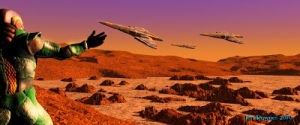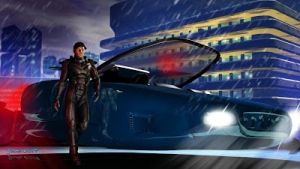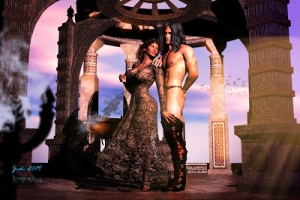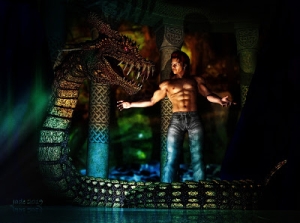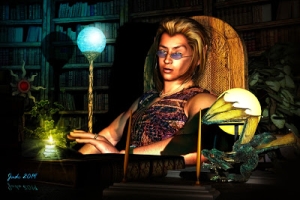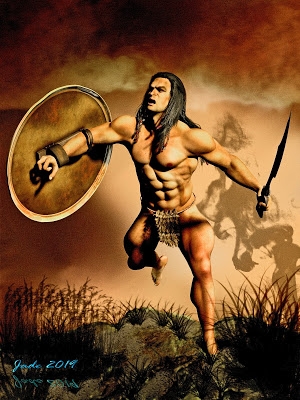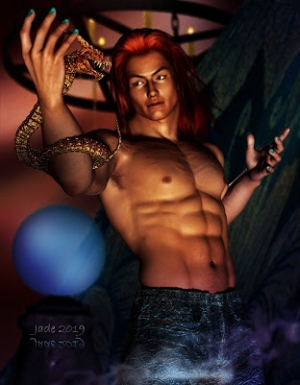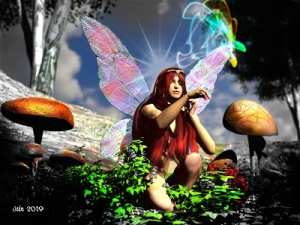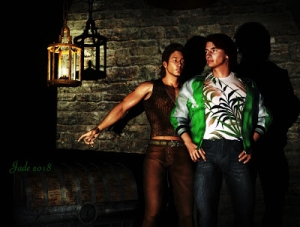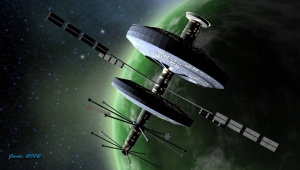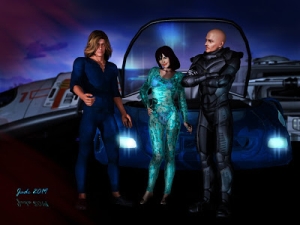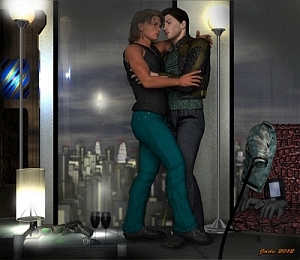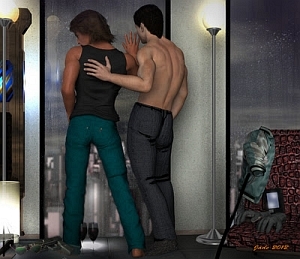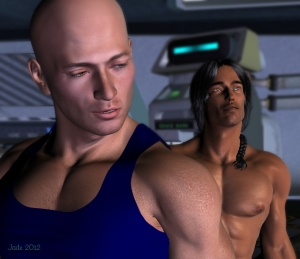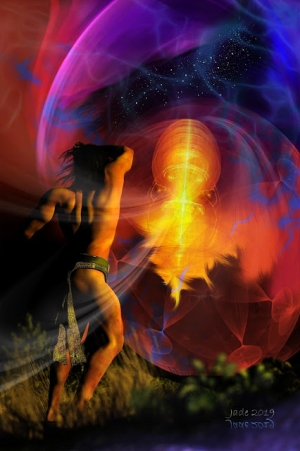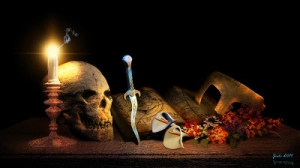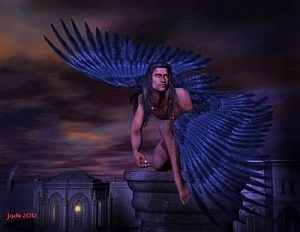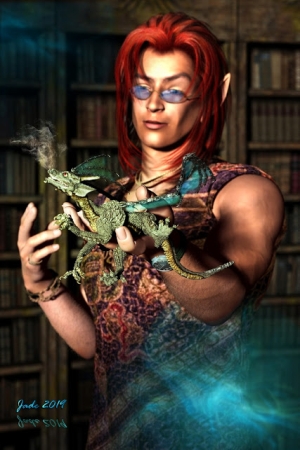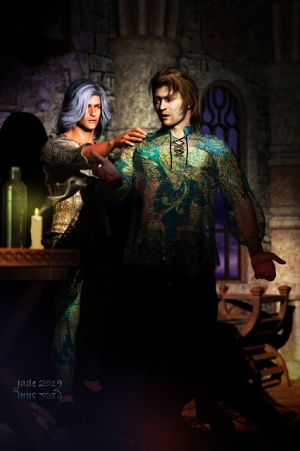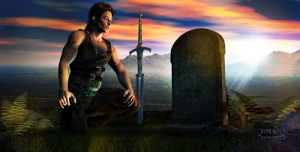 |
| LuxRender: Li with Katana |
 |
| LuxRender: the Barbarian Queen pinup |
 |
| DAZ Studio: reclining male nude |
 |
| Bryce 7 Pro science fiction: Crash! |
 |
| Bryce 7 Pro: Morning on the Mountains |
Once again -- playing catch-up and posting a whole heap of stuff at once ... images done in 2014 and 2015, while life has been too hectic, and too weird, for me to post here regularly. Gotta say, am rather pleased with the work that's been done lately. There's a complexity to even the simplest of these shots; and a great deal was invested in each one, even though sometimes it might be too subtle for you to actually
see it. Like this:
 |
| Hand-painting hair in Photoshop, over a DAZ Studio render |
I know, I know, I always swore hand painting hair was one thing I
wouldn't get into because, frankly, it can take twice as long as the render time to get handsome results. But ... well ... the thing of it is, as I get more and more into LuxRender, I'm just getting used to the fact you
have to hand paint the hair in almost every instance, because the render engine makes a DAZ toupee look like a plastic bag whacked onto the model's head. Ack. And here's the rub: once you get used to the results of hand-painted hair on the LuxRender shots, you don't really like the results you often get in DAZ Studio renders! So, what the hey? I'm painting the hair now ... and getting better at it. Check out the image, above, at full-size, see what I mean: this outtake is 1000 pixels wide, cropped right out of the original render --
Half the trick is rendering HEEE-UUGE. The shot was done at 3000 pixels wide to give me enough wiggle space to get in and paint realistic hair! Not too bad, if I do say so myself. In fact, the digital painting is a lot of fun, and the more you do it, the more you get to like it. Once upon a
long time ago, I used to get into whatever paint program only to touch up images, where "artifacts" had appeared in the render or photo. Now, the painting aspect is something I enjoy so much, I look forward to it, and use it to add dimensions on top of the original render. Like this:
In the mountainscape, though it doesn't hit you in the eyeballs, there are
fourteen layers of subtle painting to get this effect; though in the crash site image, above, it's just the birds, the waves in the background and the smoke rising off the wreck, everything else is in the original Bryce render. The burned hull of the crashed ship was done by replacing the MAT file on the OBJ with a kind of rusty, nasty "old metal" texture. The water in the foreground was done by having a semi-opaque water layer with a foamy texture/material laid over a "ground plane" with a pebbly-sandy texture, so you can "see the bottom" through the water."
In fact, the results you can get in Bryce sometimes rival those you can get in LuxRender. If only Bryce would do realistic trees, I wouldn't be looking at Vue with such longing! But it doesn't, and won't ... well, not without spending about A$60
per 3D tree
model, and only being able to load up two or three of these in a scene before Bryce goes whacko and crashes in every direction...
Regarding realistic tree models that Bryce, or any prog, can and will use ... oooh yes, I found 'em. I know where they are:
Turbo Squid: Trees. But, as gorgeous as these models are, they're somewhat prohibitively expensive for a hobbyist. You'd have to get at least half a dozen models to get enough variety for your renders to be credible, so you're looking at 6 x $39 ... then remember that the Aussie Dollar is sitting at 72c right now, and going down like the proverbial lead balloon; so the price tag for this little shopping spree would be around A$325! Eep.
Not just at the moment, guys ... also, I have my doubts as to how Bryce 7 Pro will handle such complex models. It (or at least my copy of it, on my platform) is tremendously crash-prone when scenes get complex, with lots of objects. And ... wellll, if I had three or four hundred bucks going spare, I'd get my hybrid boot drive and install Vue instead!
Right now, though, am quite happy with what I'm doing in Bryce. If you just avoid trees, you get very good shots. In fact, it's only the palm trees on the beach that let the
Crash! image down a bit. If you look too closely at them, they don't hold up, and if/when I do start buying complex trees, this is one shot I'll re-render to bring it right up to speed with near-photo quality results.
Speaking of photo quality --
 |
| 3D render or photograph? |
There's something, just
something, that says to the human eye, this is a 3D render ... but all it can be, I think, is that the hand, or skin, on the model, above, ain't as bashed up as we humans tend to get. The render itself (LuxRender, obviously), is flawless -- that's the old Michael 4 holding Merlin's Katana model, which was Photoshop-painted after rendering. The Li-with-Katana shot is actually a re-render of an old, old image which appeared on the blog a loooong time ago; so long ago, in fact, I have no idea where the original shot is! Gotta love LuxRender --
Which is not to sell Bryce 7 Pro
too short, because there's so much you can do with textures, it starts to be a real pleasure to work with:
 |
| Water effects in Bryce 7 Pro |
 |
| Lichen on rock - texture effects in Bryce 7 Pro |
 |
Bryce 7 Pro -- atmospherics: love that skyline, and it's in the
original render, not overpainted. Nice! |
 |
Bryce 7 Pro: water effects -- even wet sand on the shore.
Now, if Bryce would only do realistic trees...!
|
Hey, wet sand right above the waterline! Now, how did I do that?! It was actually fairly easy. Made a little shape, jogged it into place, flattened it right out and jogged it down till it juuuust sits on the sand there; made it very transparent and reflective, and applied a simple water texture. This is so cool ... am having loads of fun with Bryce lately.
More soon -- and am also looking (gasp!) at
Abraxas again. For the longest time, I
lost the plot notes that laid out the story to Chapter 26! Then, just the other day, they turned up ... and the imagination is sparked again. With any luck, I'll be able to pick up the threads and go on with this. Fingers crossed!
























































































